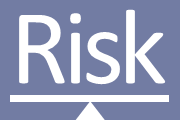|
I somehow neglected to add an article I published in January, joint with Colleen Flood, entitled "It’s time to start properly risk managing our COVID crisis response". Of course, the specific details of where we were in the pandemic then, and the steps being taken, are no longer relevant. But the underlying themes of preparing for uncertainty with scenarios, harnessing diverse views, and being ready to change track still apply, and not only in Ontario.
Available at www.theglobeandmail.com/canada/article-risk-management-omicron-crisis-response-covid-19/ (Globe and Mail op-ed) and rsc-src.ca/fr/voix-de-la-src/it%E2%80%99s-time-to-start-properly-risk-managing-our-covid-crisis-response (Royal Society of Canada COVID publication series). I've published a new article in StrategicRISK magazine's "Changing risk" series: When to think about risk?
There are specific moments in a company's business activities when a systematic look at risk is particularly worthwhile. It's more than "once a year to satisfy the Board/regulators" and more finely tuned than the old bromide, "all the time". One of the (many) bugbears of risk management is the perceived tension between "objective", data-grounded quantitative risk assessments and "subjective" estimates where data is lacking, or needs adjusting due to context. Just presented at a metallurgical conference on some joint work with engineering consultancy Hatch on bridging this gap for prioritizing catastrophic safety risk, though the methods have broader applicability.
Here is a preprint of the article version, to appear in the (peer reviewed) conference proceedings. More musings on COVID and risk management, for those interested. Perhaps more relevant for countries like Canada, Europe, Asia where wave 1 has passed, than e.g. the US, but arguably short-circuiting the question of risk appetite is part of the reason wave 1 hasn't passed in those other places.
Posted at www.linkedin.com/pulse/getting-serious-covid-risk-appetite-martin-pergler/ My risk manager's take on (Canadian, maybe even Canada vs US) COVID response.
www.linkedin.com/pulse/covid-response-failure-analytical-imagination-martin-pergler/ Getting COVID steals a year of your remaining actuarial life, regardless of your age. That's the interesting conclusion of this chart (not mine) that plots the COVID infection mortality rates versus age cohort on the same axes as actuarial chance of death in one normal year.
Of course, there are lots of caveats in this apples-to-oranges comparison. It's simple age cohorts, US normal death rates, and -- most importantly -- assumes we still succeed in flattening the curve enough for medical care to be there for those who need it. If not, it might be 2-3 years of actuarial life rather than 1. (It's a bit hard to find in the comment thread: the data is IFRs from the Imperial study, i.e. P(death|tests positive AND ventilators available), not P(death) overall.) For those still reading under the fold, this type of lifespan-reduction analysis from risks taken, voluntarily or involuntarily, is explored further (8 years ago, so pre COVID) by Prof David Spiegelhalter at Cambridge University in his concept of microlives. [Originally posted on LinkedIn and facebook]. People seem to be increasingly internalizing and accepting efforts prudentially required to slow down COVID-19s exponential infection rates. And hopefully we'll converge even more from the poles of "barricade ourselves behind hoarded toilet paper" and "what me worry, I don't see a problem yet" behaviour. However, given differences in, and evolution over time of, testing and reporting around the world, we also need to get ahead of monitoring the evolution of the outbreak and its containment in different geographies. We've all seen the "buy time to flatten the curve" graphic many times by now, but I think we all hope we can minimize the area under the curve, not just flatten it.
With this in mind, I'm happy to see a paper on statistical time series modeling applied to localized contagion dynamics cross my desk, from Italy no less! Pretty technical in nature, and frankly there isn't truly enough data to draw any actionable conclusions yet, but we're going to need analysis of this type to be able to extrapolate sensibly going forward, and to judge to what extent containment approaches -- including different intensities of social distancing -- are working. As a minor improvement (and I've reached out to the author), one could consider adding a "medium-term dependence" factor over a sliding window of length equal to the incubation time. While this factor does become embedded in the long-term dependence factor, i.e. is not neglected, separating it out might allow monitoring and comparing effectiveness of social distancing measures, over time and between geographies. Arianna Agosto and Paolo Giudici (University of Pavia), A Poisson autoregressive model to understand COVID-19 contagion dynamics, March 9 2020. https://papers.ssrn.com/sol3/papers.cfm?abstract_id=3551626 By the way, this article in the Lancet ( https://www.thelancet.com/journals/lancet/article/PIIS0140-6736(20)30567-5/fulltext ) outlines some of the tradeoffs of managing spread vs long term social/economic impact, given significant and sustained reduction of R0 is needed. |
Martin PerglerPrincipal, Balanced Risk Strategies, Ltd.. Archives
February 2023
Categories |
Copyright © 2014-2020, Balanced Risk Strategies, Ltd. – Contact us


 RSS Feed
RSS Feed